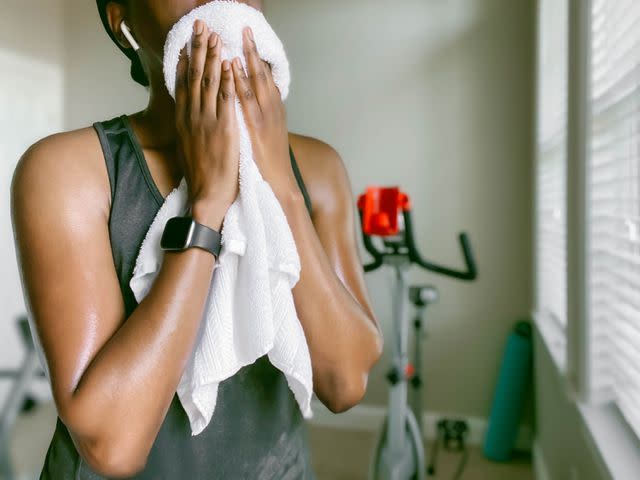Heat Rash Remedies: At-Home Treatment, Self-Care, and OTC Options
Medically reviewed by Katlein Franca, MD
A heat rash (prickly heat or sweat rash) is a painful skin condition that itches and burns because the skin has gotten too hot. It appears as small, pink bumps on light skin tones and white bumps on dark skin tones. It commonly occurs in sweat-prone body areas, like armpits, groin, and elbows.
Sweat trapped under the skin blocks sweat glands and causes heat rash. Heat rash isn’t serious and often disappears in cool temperatures, but it’s very uncomfortable.
This article discusses at-home heat rash remedies, including natural home remedies, self-care methods, and over-the-counter (OTC) topicals and medications.

Grace Cary / Getty Images
Home Remedies for Heat Rash
If you've noticed those pesky spots on your skin, you're likely looking for ways to eliminate them. The good news is there are plenty of ways to treat heat rash at home.
Oatmeal
Colloidal oatmeal can soothe, soften, and increase the skin's moisture. Research shows that colloidal oatmeal can do this for many different types of rashes.
Colloidal oatmeal has the following benefits:
Reduces inflammation
Improves skin dryness
Reduces scaling
Reduces roughness
Reduces itch intensity
You can find colloidal oatmeal in preparations that you can add to a bath or in lotions you apply directly to the skin.
Related: Heat Rash vs Eczema: What Are the Differences?
Sandalwood
Research found sandalwood oil has the following properties, which may relieve the symptoms of some skin conditions:
Anti-inflammatory
Antimicrobial
Antiproliferative (inhibits cell growth)
Baking Soda
Baking soda treats skin conditions like eczema because it helps relieve the itch associated with some rashes. If your heat rash is very itchy, a baking soda paste or bath could offer some relief.
Related: Step-by-Step Guide to Using Baking Soda for Eczema
Aloe Vera
Aloe vera is a gel many apply to skin ailments like sunburn. However, it can also be used for other skin wounds and rashes for similar relief.
Research has found aloe has the following properties and may offer relief from heat rash symptoms:
Anti-inflammatory
Skin protection
Antibacterial
Antiviral
Wound healing
Unscented Talcum Powder
Talcum powder is made from talc. Some use it to help keep skin dry and prevent rashes. However, talcum powder has been linked to some kinds of cancer in humans. You may want to limit or avoid using it or choose a powder without talc.
Neem
Neem is a traditional medicinal plant that may help with rashes, including heat rash. It has the following properties:
Anti-inflammatory
Antibacterial
Antiviral
Antifungal
Immunomodulatory
Antioxidant
Most people apply neem oil directly to the skin. Look for organic oils not sourced from plants exposed to fertilizers and pesticides. Always use diluted oil and test it on a small skin patch first.
Epsom Salt
Epsom salts are often used in baths to relieve tension and soothe skin. Epsom salt baths may also help with heat rash. Add about 2 cups of Epsom salt to warm water to use in a bath. Soak for up to 15 minutes.
Self-Care Methods
In addition to at-home remedies, some heat rash self-care techniques may help to quickly relieve heat rash.
Cool Baths and Showers
Cooling the skin is a critical step in treating heat rash. A cool bath or shower can be an excellent first step. You can bathe for up to 10 minutes, being careful not to get chilled. Repeat up to three times a day.
Fans and Air Conditioners
Along with cooling the skin with a bath or shower, you should also reduce the air temperature in your home. Lower the central air temperature or turn on your window air-conditioning unit. Alternately (or additionally), sitting in front of a fan may provide extra relief.
Wear Light, Moisture-Wicking Clothing
One of the keys to resolving heat rash is to reduce sweat and heat on the skin. Stay away from tight, warm, clingy clothes. Opt instead for light, moisture-wicking clothing. Loose cotton tops, tunics, dresses, and flowy bottoms are all excellent options.
Ice Packs or Cold Washcloths
Reduce the heat on your skin by applying a cool compress directly to the area. You can either use ice packs or a cool, wet washcloth.
OTC Medications
For OTC heat rash treatment, certain products can soothe skin, reduce swelling, and relieve itching.
Ointments
Calamine lotion is a good option for instant itch relief. When you apply calamine to the skin, it dries, leaving a film of medication behind. Calamine lotion is anti-inflammatory and antipruritic (anti-itch). You can find it online, in pharmacies, and in drug stores.
Antihistamines
Antihistamines like Benadryl can help relieve the itch associated with heat rash. Options for OTC antihistamines include topical creams or tablets.
Steroid Creams
Steroid cream is a primary cream that relieves heat rash. Topical steroids (corticosteroids) reduce inflammation and itch. This makes them an excellent choice for heat rash symptoms. These are available OTC, and a stronger preparation is available by prescription.
How Long Does a Heat Rash Last?
Most mild cases of heat rash go away just a day or two. However, if your rash is more severe, it may last a week. The fastest way to eliminate a heat rash is to cool the body, prevent skin irritation, and soothe the skin using one or more of the above methods.
Related: Heat Rash vs. Sun Poisoning: What’s the Difference?
When to Contact a Healthcare Provider
You should contact a healthcare provider if your heat rash doesn't go away within a week or is accompanied by the following:
Pain
Intense itching
The rash appears to be infected
Summary
There are many methods for treating heat rash at home, including at-home remedies, self-soothing treatments, and OTC medicine. Whatever you choose, aim to cool and soothe the skin and reduce friction. When treated early and effectively, heat rash doesn't last long.
Read the original article on Verywell Health.

